牛津高中英语牛津版译林版高一模块一Unit1教案
2021牛津译林版高中英语必修一 Unit1 Extended reading教学设计
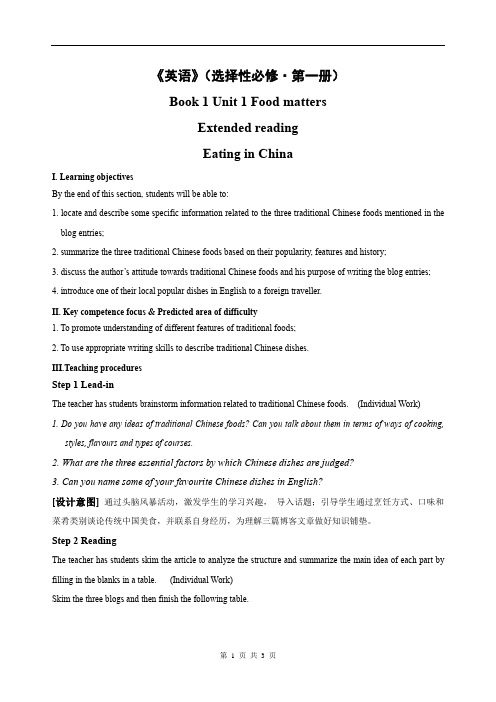
《英语》(选择性必修·第一册)Book 1 Unit 1 Food mattersExtended readingEating in ChinaI. Learning objectivesBy the end of this section, students will be able to:1. locate and describe some specific information related to the three traditional Chinese foods mentioned in the blog entries;2. summarize the three traditional Chinese foods based on their popularity, features and history;3. discuss the author’s attitude towards traditional Chinese foods and his purpose of writing the blog entries;4. introduce one of their local popular dishes in English to a foreign traveller.II. Key competence focus & Predicted area of difficulty1. To promote understanding of different features of traditional foods;2. To use appropriate writing skills to describe traditional Chinese dishes.III.Teaching proceduresStep 1 Lead-inThe teacher has students brainstorm information related to traditional Chinese foods. (Individual Work)1. Do you have any ideas of traditional Chinese foods? Can you talk about them in terms of ways of cooking,styles, flavours and types of courses.2. What are the three essential factors by which Chinese dishes are judged?3. Can you name some of your favourite Chinese dishes in English?[设计意图] 通过头脑风暴活动,激发学生的学习兴趣,导入话题;引导学生通过烹饪方式、口味和菜肴类别谈论传统中国美食,并联系自身经历,为理解三篇博客文章做好知识铺垫。
牛津高中英语牛津版译林版高一模块一Unit1教案
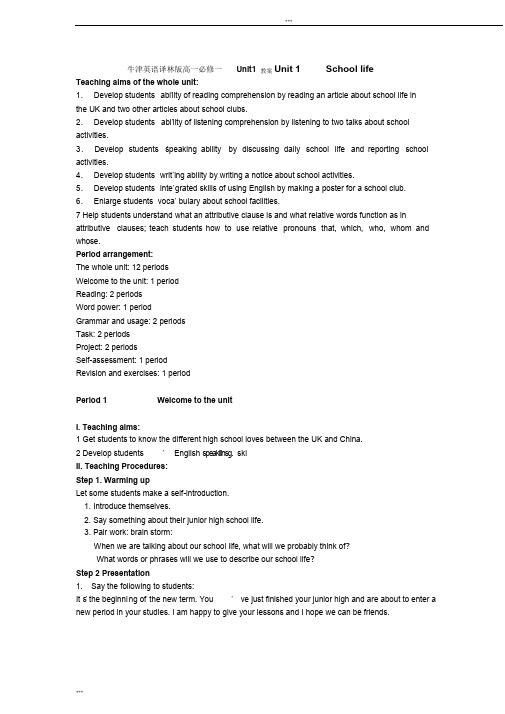
牛津英语译林版高一必修一Unit1 教案Unit 1 School lifeTeaching aims of the whole unit:1.Develop students abi’l ity of reading comprehension by reading an article about school life inthe UK and two other articles about school clubs.2.Develop students abi’lity of listening comprehension by listening to two talks about school activities.3.Develop students s’peaking ability by discussing daily school life and reporting school activities.4.Develop students writ’ing ability by writing a notice about school activities.5.Develop students inte’grated skills of using English by making a poster for a school club. 6.Enlarge students voca’bulary about school facilities.7 Help students understand what an attributive clause is and what relative words function as in attributive clauses; teach students how to use relative pronouns that, which, who, whom and whose.Period arrangement:The whole unit: 12 periodsWelcome to the unit: 1 periodReading: 2 periodsWord power: 1 periodGrammar and usage: 2 periodsTask: 2 periodsProject: 2 periodsSelf-assessment: 1 periodRevision and exercises: 1 periodPeriod 1 Welcome to the unitI. Teaching aims:1 Get students to know the different high school loves between the UK and China.2 Develop students ’English spe ak lil n s g. skiII. Teaching Procedures:Step 1. Warming upLet some students make a self-introduction.1. Introduce themselves.2. Say something about their junior high school life.3. Pair work: brain storm:When we are talking about our school life, what will we probably think of?What words or phrases will we use to describe our school life?Step 2 Presentation1. Say the following to students:It s’the beginni ng of the new term. You ’ve just finished your junior high and are about to enter a new period in your studies. I am happy to give your lessons and I hope we can be friends.I can see that some of your are eager to know what studying at senior high will be like. Will it be differ4ent from junior high? Well, there are certainly many differences between junior high and senior high, but there are also some things that are the same in every school in China.What about schools in other countries? Do you have different experiences? Are schools all overthe world the same? This is the subject of our first unit.2. Ask students to read the instruction and tell them:Here are three pictures that show some aspects of school life in the UK. Please read the instructions, look at the pictures: what's the difference between schools in China and the UK?Step 3 Discussion1 Ask students the following questions to talk about the words in the four pictures:Huge campus and low-rise buildingsWhat does h uge mean?What does low-rise mean?What about campus and school buildings in China?(Schools in China usually have a large enough campus to make sure students have enough space to study and play. But most school buildings have at least 3 storeys.)Lockers for every studentDo you know what a locker is?(There are rows of lockers by the classrooms for students to put their bookd, exercise-books and other belongings.)What do you think about locker for students?Do you think that we should have such locker in our school? Why or Why not?Fewer students in each classHow many students are there in our class?Do you know the number of students in a class in the UK?At ease with our teacherWhat can we know from this picture?What does the word ease mean? What do you think the phrase at ease mean?Were you getting on well with the teacher when you were in junior high?What relationship do you want to have with your teachers in senior high?2 Ask students to work in groups to talk about the four pictures and the differences betweenschools in the UK and China. Then ask several students to report their discussion to the whole class.aspects In the UK In ChinaHuge campus and We can see huge campus Schools in China usually have a large enoughlow-rise buildings and low-rise buildings. campus to make sure students have enough space to It is the biggest difference study and play in.from schools in China But most school buildings are taller, at least threestoreys.Lockers for every There are rows of lockers Students bring what they need for lessons to school student by the classrooms for and then take it all back home after school. Most students to put their schools in china do not have equipment in thestationary, books, classroom.exercise-books and otherbelongings.Fewer students in There are fewer studentsThere are usually more students in high school, each class in a class, no more than perhaps 40 to 50 per class. Recently some schools30 per class. are beginning to limit the number of students ineach class.At ease with our Students have a close It is similar in china. Nowadays, lots of teachers and teacher relationship with their students have established a good relationship with teachers. They feel at easeeach other. They respect each other and work toand comfortable with gain a better understanding of each other.them.4. Ask students to discuss the three questions in pairs, and them ask some of them to report their answers to the questions to the whole class.What is your dream school life like?What kind of school activities do you enjoy?What do you think of your life here in the new school?Step 4 Summary and HomeworkToday we ’ve mainly talked about the differences between the high school lives in the UK and in China. After class you should:1) Recall all the new words and expressions that we learn in this lesson.2) Find more about any other differences between the high school lives in the UK and in China, either by surf the Internet or by reading some articles in newspapers or magazines.3) Preview the following part: reading (page 2 to page 4).。
【同课异构】高一英语(牛津译林版)必修一教案 unit1 School life welcome to the unit

Welcome to the unit 教案Step 1T: Welcome to our school.It’s the beginning of a new term. You have just finished junior high and are about to enter a new period in your studies. I am very happy to have all of you in my class and I hope we can be friends..I am your English teacher this year.First of all,allow me to introduce myself to you. My first name is Zong.So you can call me Mr Zong or Teacher Zong.I like playing computer, listening to music and reading in my free time.In a word, I like my job teaching very much.I do hope to have a good time with you.T: Just now I introduced myself to you.Now I want to ask some of you to introduce yourself to us.Any volunteers? What’s your name? S1: My name is... T: Do you have any hobbies? S2:I like ...T: Which school did you graduate from? S3:I came from No.1 Middle school.T:your name,please? S4:My name.....T:Which school are you from?S5:....active learningenjoy losing facerenew学习习惯1、课前预习课后复习不算作业,是一种习惯。
译林牛津江苏省高一英语必修模块一Unit1上教案及练习 牛津英语 教案
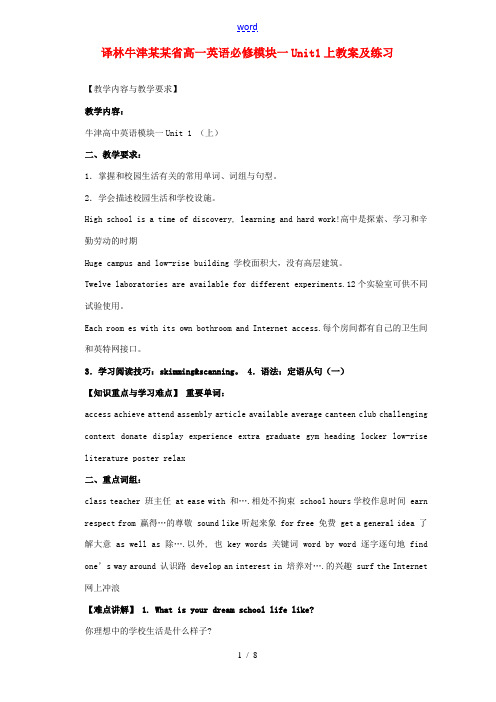
译林牛津某某省高一英语必修模块一Unit1上教案及练习【教学内容与教学要求】教学内容:牛津高中英语模块一Unit 1 (上)二、教学要求:1.掌握和校园生活有关的常用单词、词组与句型。
2.学会描述校园生活和学校设施。
High school is a time of discovery, learning and hard work!高中是探索、学习和辛勤劳动的时期Huge campus and low-rise building 学校面积大,没有高层建筑。
Twelve laboratories are available for different experiments.12个实验室可供不同试验使用。
Each room es with its own bothroom and Internet access.每个房间都有自己的卫生间和英特网接口。
3.学习阅读技巧:skimming&scanning。
4.语法:定语从句(一)【知识重点与学习难点】重要单词:access achieve attend assembly article available average canteen club challenging context donate display experience extra graduate gym heading locker low-rise literature poster relax二、重点词组:class teacher 班主任 at ease with 和….相处不拘束 school hours学校作息时间 earn respect from 赢得…的尊敬 sound like听起来象 for free 免费 get a general idea 了解大意 as well as 除….以外, 也 key words 关键词 word by word 逐字逐句地 find one’s way around 认识路 develop an interest in 培养对….的兴趣 surf the Internet 网上冲浪【难点讲解】 1. What is your dream school life like?你理想中的学校生活是什么样子?这里 dream 表示心目中最理想的. 如 dream team (梦之队)。
Unit1ExtendedreadingNewsthatMatters教案高中英语牛津译林版(202

3. Role play and find out the attitude of the third guest.
Archer’s opinion:
We have to achieve a balance between environmental
StepⅦ.Summary
教案
T: Lucid waters and lush mountains are invaluable assets. 绿水青山就是金山银山
1.Review the phrases in the blanks. 2.Ask students to retell what they have learned.
Protection mittee
StepⅣ. Careful reading
T:What attitudes may they take towards environmental protection? Read para3. and check your prediction. 1.Fill in the blanks to find out the attitude of the first guest.
主备人 班级 课题
教学 目标
教案
总第 节
陈晓琳
参与人
执教人
审
K2214
时间
核
人
News that Matters: pollution in Norgate
课 时
1
1.Most students know many key words and phrases and their relevant expressions after learning this passage.1.rapid development 快速发展;2.get rid of 摆脱;
牛津译林版(2020)高中英语选择性必修第一册Unit1教案

《英语》(选择性必修·第一册)Unit 1 Food mattersIntegrated skills (II)I. Learning objectivesBy the end of the lesson, students will be able to:1. talk about their favorite food, including its appearance, smell, taste, ways of cooking and a particular experience associated with it;2. write an article about their favorite food.II. Key competence focusWrite an article about their favorite food.III. Predicted area of difficulty1. How to convey the ideas clearly.2. How to write an article vividly.IV. Teaching proceduresStep 1 Lead-in1.T presents some pictures of food such as mooncake, Tiramisu, dumpling, hot pot, etc. and asks the following questions:Picture 1 (Mooncake)T: What can you see in the picture?S: Mooncakes.T: Have you tried a mooncake?S: Yes.T: When did you try it for the first time?S: I gave it my first try at the age of 5.T: Do you like it?S: Yes, very much.T: How does it taste?S: It tastes sweet.Picture 2 (Tiramisu)T: Do you know the dessert in the picture?S: It is Tiramisu.T: How does it look?S: It looks adorable.Picture 3 (Dumpling)T: What’s the picture about?S: Dumplings.T: Do you know how to cook the dish?S: It can be steamed, boiled or fried.Picture 4 (Hot pot)T: What’s it?S: It’s a hot pot.T: How do you think it feels in your mouth?S: I think it is spicy.2. T asks more questions as follows:T: What’s your favorite food? Why do you like it?(Ss may give various answers.)3. T shows a picture of salted duck and mentions her experience of tasting it for the first time.T: Salted duck is one of my personal favorites. I gave it my first try twenty years ago, together with my family members. My father went on a business trip to Nanjing and brought one back. Itlooked mouth-watering. Before my mother sliced it, brother and I couldn’t wait to have a try. The meat was juicy and salty, which really impressed all of us. How can I forget such a tasty dish?【设计意图:通过互动,引入主题,并为对话环节做铺垫。
牛津译林版英语必修一Unit1Welcometotheunit教案
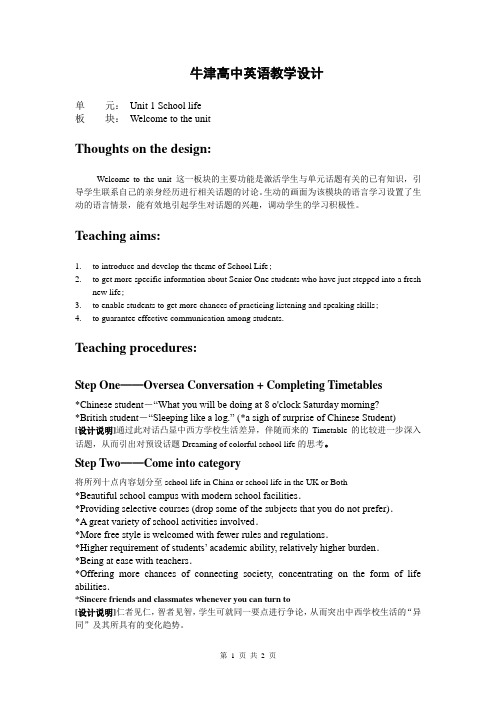
牛津高中英语教学设计单元:Unit 1 School life板块:Welcome to the unitThoughts on the design:Welcome to the unit 这一板块的主要功能是激活学生与单元话题有关的已有知识,引导学生联系自己的亲身经历进行相关话题的讨论。
生动的画面为该模块的语言学习设置了生动的语言情景,能有效地引起学生对话题的兴趣,调动学生的学习积极性。
Teaching aims:1.to introduce and develop the theme of School Life;2.to get more specific information about Senior One students who have just stepped into a freshnew life;3.to enable students to get more chances of practicing listening and speaking skills;4.to guarantee effective communication among students.Teaching procedures:Step One——Oversea Conversation + Completing Timetables*Chinese student-“What you will be doing at 8 o'clock Saturday morning?*British student-“Sleeping like a log.” (*a sigh of surprise of Chinese Student)[设计说明]通过此对话凸显中西方学校生活差异,伴随而来的Timetable的比较进一步深入话题,从而引出对预设话题Dreaming of colorful school life的思考。
牛津译林版英语必修一Unit1Reading2教案

牛津高中英语教学设计单元:Unit1 School life板块:Reading (Language focus)教学设计指导思想:本课按照“点、线、面—单词、词组、句型”设计,课本主要词汇attend,drop,miss,experience通过幻灯片重点讲解, average, earn, challenging, extra, for free, used to 等以填空的形式呈现,相关短语教师口头陈述,学生举例运用。
最后学习动名词作主语并初步了解定语从句。
用所学词汇编故事。
Teaching aims:1.to learn the use of some important words and phrases;2.to get some idea about attributive clause and gerund as subject;3.to organize important words and phrases into paragraph.Step1 RevisionInterview: Suppose you have a chance to interview Wei Hua …Apart from the things you have been told, what other information would you like to know about her life and study in the UK.Ask her as many questions as possible.Step2 Language focusShowing some pictures (including attending class/school, attend a church, attend assembly, attend a wedding) to indicate “attend”.1. On the first day, all the students went to attend assembly.(1) vt.出席,参加(2) attend (on) sb. 照料某人,看护某人attend to sb.(3) attend to sth. 注意,专心干(某事)Exercises concerning “attend”.Distinguish the following four notions: “attend, join, join in, take part in”1) He _______ the army in the year of 2003.2) How many of you will ____________ the coming sports meeting?3) Who is going to ____________ the concert with me tomorrow?4) W on’t you ________ us ______ the tennis match?2. Students at that school have to study Math, English and Science, but can drop some subjects if they don’t like them. drop v. 放弃,落下,断绝(往来),减少,降低Try to tell the meaning of “drops”in the following sentences.1) It was so quiet that you could hear a pin drop.2) His voice dropped. / He dropped his voice to a whisper.3) Please drop me at the Post Office.4) It is wise of you to drop the habit of smoking. _______Drop n.滴;点; 下降;落下;下跌a drop of water 一滴水eye drops 眼药水teardrops 泪珠 a drop in the price of wheat小麦价格下跌e.g.1.The worldwide economic recession has led to ___________in people’s salary. (下降)2. I didn’t see any _________ on Liu Xiang’s face when he quit running in the Olympic GamesV ocabulary extensiondrop in / by顺便拜访drop sb. a line 写封短信drop in on sb. 造访某人drop in at a place造访某地1) The headmaster asked me to_________ him at his office. 校长让我去他办公室。
牛津译林版(2020)高中英语选择性必修第一册Unit1教案

《英语》(选择性必修·第一册)Unit 1 Food mattersExtended readingI. Learning objectivesBy the end of the period, students will be able to:1. get the main information about the three traditional Chinese foods;2. write a summary of each of the three traditional Chinese foods;3. appreciate some nice words and understand their meanings and functions;4. find out the author’s views about these traditional Chinese foods and show their own opinions;5. introduce a popular dish in their hometown.II. Key competence focus1. Get the main information about the three traditional Chinese foods.2. Find out the author’s views about these traditional Chinese foods and give some opinions.III. Predicted areas of difficulty1. Write a summary of each of the three traditional Chinese foods.2. Appreciate some nice words and understand their meanings and functions.3. Introduce a popular dish in the hometown.IV. Teaching proceduresStep 1 Lead-inFree talkAfter greeting Ss, T has a free talk with them: eating is of great importance in our daily life. What food do you usually have for lunch and dinner? Then T asks Ss a question: what’s your favorite food and can you introduce something about it?【设计意图:通过自由交谈导入本节课,让学生畅所欲言讲讲自己最喜欢的食物并简单介绍,激活学生已有知识并激发学生的阅读兴趣。
高一英语(译林牛津版) 必修一教师用书 Unit1 School life
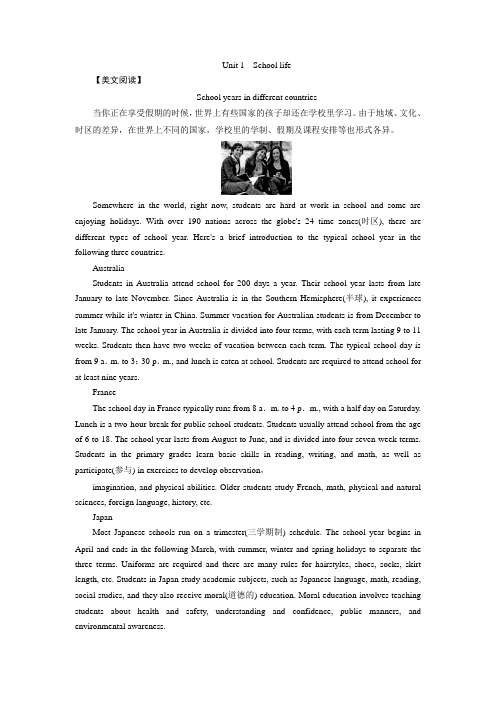
Unit 1School life【美文阅读】School years in different countries当你正在享受假期的时候,世界上有些国家的孩子却还在学校里学习。
由于地域、文化、时区的差异,在世界上不同的国家,学校里的学制、假期及课程安排等也形式各异。
Somewhere in the world, right now, students are hard at work in school and some are enjoying holidays. With over 190 nations across the globe's 24 time zones(时区), there are different types of school year. Here's a brief introduction to the typical school year in the following three countries.AustraliaStudents in Australia attend school for 200 days a year. Their school year lasts from late January to late November. Since Australia is in the Southern Hemisphere(半球), it experiences summer while it's winter in China. Summer vacation for Australian students is from December to late January. The school year in Australia is divided into four terms, with each term lasting 9 to 11 weeks. Students then have two weeks of vacation between each term. The typical school day is from 9 a.m. to 3:30 p.m., and lunch is eaten at school. Students are required to attend school for at least nine years.FranceThe school day in France typically runs from 8 a.m. to 4 p.m., with a half day on Saturday. Lunch is a two-hour break for public school students. Students usually attend school from the age of 6 to 18. The school year lasts from August to June, and is divided into four seven-week terms. Students in the primary grades learn basic skills in reading, writing, and math, as well as participate(参与) in exercises to develop observation,imagination, and physical abilities. Older students study French, math, physical and natural sciences, foreign language, history, etc.JapanMost Japanese schools run on a trimester(三学期制) schedule. The school year begins in April and ends in the following March, with summer, winter and spring holidays to separate the three terms. Uniforms are required and there are many rules for hairstyles, shoes, socks, skirt length, etc. Students in Japan study academic subjects, such as Japanese language, math, reading, social studies, and they also receive moral(道德的) education. Moral education involves teaching students about health and safety, understanding and confidence, public manners, and environmental awareness.From:http://www.factmonster. com【诱思导学】1.What is the difference between our school year and theirs?【答案】We have different terms. There are usually two terms in our school year while in both Australia and France, they have four terms and Japan has three.2.Do you think our present school year is good or not, and why?【答案】It is hard to say good or bad because different countries lie in different time zones, they enjoy different holidays and different schools.3.Do you want to know the school life in the UK?Why or why not?【答案】Yes. Because the school life in the UK interests me very much./No. Because I have no interest in the school life there. It's none of my business.Period ⅠPreviewing(教师用书独具)●教学目标本课时主要是通过学生对学案所给出的内容的学习,了解本课文中所出现的词汇,初步了解课文以及相关的背景知识,对下一堂课课文的全面理解起到一个铺垫作用。
【英语周报】牛津译林版高一模块一Unit 1 School life备课资料:教案 Welcome to the unit [ 高考]
![【英语周报】牛津译林版高一模块一Unit 1 School life备课资料:教案 Welcome to the unit [ 高考]](https://img.taocdn.com/s3/m/efd65dd3941ea76e58fa045f.png)
Welcome to the UnitTeaching goals1. Target languageImportant words and expressions: low, locker, outdoor activities2. Ability goalsEnable the students to compare junior school life with high school life.3. Learning ability goalsHelp the students learn how to compare junior school life with high school life. Teaching important & difficult pointsLearn to compare junior school life with high school life.Teaching methodsDiscussion.Teaching aidsA computer and a projector.Teaching proceduresStep I Free TalkMake a self-introduction and talk about junior school life with the students.T: Hello, everyone. Welcome to the senior high English class. I'm××. I have been here teaching English since I graduated from××University more than 10 years ago. Therefore, I've made a lot of friends. Now I'm very glad to learn English together with you this year and I'm sure we'll soon become friends, too. Now you've just finished your junior school life and are about to enter a new period in your studies. Do you feel nervous?SI: Not at all. I've made some preparations before I came here.S2: A little. The new school is quite different from the one I was in.S3: Yes, I do feel nervous. Everything here is new and strange to me.S4: No. I don't feel nervous. Because I'm sure I can do my school work better here. T: High school time is very important and often considered as golden time in our life. However, some of you may feel uncomfortable when first came here. What do youthink you can do to overcome these difficulties?S5: I think we can try to relax ourselves by making as many friends as possible and doing more activities.S6: There are really some differences between the life in junior and high schools. We should adjust ourselves to the new environment as soon as possible. If we have difficulties, we can ask for help from classmates and teachers.T: Well, what are the differences do you think between the life in junior and high schools are? Have you found some?S7.Yes First there are more students here from different places. In my junior school, students were all from the same town, and there were only 30 students in my old class.T: Well, can you tell us something about yourself and your school?S7: I'm from X Middle School My name is S7. There is only a three-storey building in my junior school. There were about 500 students there. And the students' dormitory is not big enough to hold all the students. As my home is not far away from the school, I had to go back home every day.T: Now you needn't go back home every day. But would you miss you parents?S7: Of course. But I'll try to overcome my feelings.T: Good. Any other differences?S8: Yes. We'll have more subjects in high school and thick books. Maybe they are more difficult to learn.T: Don't worry. Both junior and high school study are for a good foundation of all subjects. As long as you work hard, I'm sure you can be better.S9: I found there are more and higher buildings here. And more beautiful too. In our school, there is only one old five-storey building.T: Which school do you come from? Can you tell us something about your school life there?S9: I came from×middle school. It is a small but beautiful school with mountains all around. We lived at the school dorms. We used to climb the mountain at the back of the school after class and we read and played there. We used to playbasketball in the afternoon but had to go to classrooms for one-hour self-study.T: Sounds interesting. Anyway, a new school and new student body is a great opportunity to learn about people, places and cultures. I wish everyone here can make many friends and get great success in your school work in these years.Step II Welcome to the unitLook at the pictures and talk about different high school lives.T: Well, boys and girls, when we speak of school life, which English words can you think of? please look at some pictures first.Ss: (joys; sorrows; dreams; discoveries; failures; tears; successes; challenges; excitement)T: We've studied English for three or more years. What is the UK school life like? How different is it from that in China? Please look at the following pictures. They show some parts of high school in the UK. What can you see in the pictures? What are the differences between schools in China and in the UK.?T: As we all know, there are differences between school lives in junior and high schools. So there must be differences in different cultures. Some of us must be eager to know what the school life in other countries are like. For example, we've studied English for three or more years, what is the UK school life like? How different is it from in China? You know, there are many famous schools and universities in the UK. Today, we'll pick up this subject. Now read the instructions in Welcome to the unit on page 1 and focus on the pictures individually. Ask the students to talk about the pictures.T: What can you see in the pictures? What are the differences between schools in China and in the UK.S1: In Picture I-2, we can see very low houses and huge campus. They are very different from those in China. In China, we usually have large buildings and campus to make sure students have enough space to study in and play in.S2: In Picture 3-4, we can see lockers for each student outside the classroom. In China, we often have some lockers in every bedroom.S3: In Picture 5-6, we can see a larger classroom with fewer students in it. Thestudents sit in two lines and face to face. The students are putting up their hands eagerly to answer the teacher's questions. In China, we always have a full classroom with students sitting in several lines facing the blackboard And in most cases, students are not so eager to answer the teachers' questions, especially high middle school students.S4: In Picture 7-8, students in UK have a lot of outdoor activities, while students in China only have some outdoor activities in P.E. class. But they try to pay more attention on outdoor activities now.T: There are certainly many differences between the school lives in China and in the UK, as we all can see clearly from the pictures. Do you know of any other differences? S5: Certainly. I heard the students in the UK can choose whatever subject they like.S6: And they are scored A, B, C, D and E for every subject they choose instead of 100 points, 150 points, etc, such as in China or other Asian countries.T: Also, students in the UK have different school activities. For example, they organize school clubs, design posters or do volunteer work. In China, we also have many school activities. What kind of school activities do you enjoy?S7: I enjoy playing basketball after school.S8: I prefer drawing.S9: I like playing chess.T: Without varieties of school activities, school life would be boring. Most of you must have drawn a picture of what high school life would be like in your mind before you came here. Now who'd like to share your dream school life with us?S10: My dream school life is like this: there are many friendly and knowledgeable teachers; classmates get along well with each other; we study, play, sing and dance together; we have parties, etc. All in all, I'm happy with everything and everyone here.S11: My dream school life would be like this: In study, I will work harder to make great progress in every subject; I will try to do more sports to make me stronger; I will be able to learn to play computer games, etc.…T: Just as what the four pictures show, differences do exist between high schools in our country and in the UK. There are of course, many masons for such phenomena. What do you think the reasons are?S1: I think it's mainly because we belong to different cultures. Both China and the UK have a long history of civilization among which different school systems developed. It is no wonder we have different school lives.S2: I quite agree with you. China has different cultural and educational background from that of the UK, so there will be differences.S$: China and the UK have different, traditions in education and school systems. I believe each has advantages and disadvantages.Step III HomeworkT: Students in different countries learn differently and have different school life experiences. I do hope you'll have a great experience here. After class,1. Try to make a careful plan for your high school study.2. Preview the Reading.。
高中英语 Unit 1 Back to school教学 知识细解码教学案(含解析)牛津译林版必修第
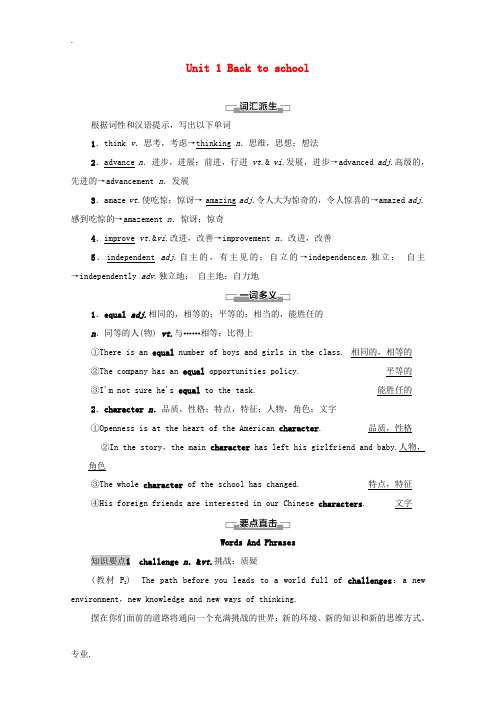
Unit 1 Back to school根据词性和汉语提示,写出以下单词1.think v.思考,考虑→thinking n.思维,思想;想法2.advance n.进步,进展;前进,行进 vt.& vi.发展,进步→advanced adj.高级的,先进的→advancement n.发展3.amaze vt.使吃惊;惊讶→ amazing adj.令人大为惊奇的,令人惊喜的→amazed adj.感到吃惊的→amazement n.惊讶;惊奇4.improve vt.&vi.改进,改善→improvement n.改进,改善5.independent adj.自主的,有主见的;自立的→independence n.独立;自主→independently adv.独立地;自主地;自力地1.equal adj.相同的,相等的;平等的;相当的,能胜任的n.同等的人(物) vt.与……相等;比得上①Th ere is an equal number of boys and girls in the class. 相同的,相等的②The company has an equal opportunities policy. 平等的③I'm not sure he's equal to the task. 能胜任的2.character n.品质,性格;特点,特征;人物,角色;文字①Openness is at the heart of the American character. 品质,性格②In the story,the main character has left his girlfriend and baby.人物,角色③The whole character of the school has changed. 特点,特征④His foreign friends are interested in our Chinese characters. 文字Words And Phrases知识要点1challenge n.&vt.挑战;质疑(教材P2) The path before you leads to a world full of challenges:a new environment,new knowledge and new ways of thinking.摆在你们面前的道路将通向一个充满挑战的世界:新的环境、新的知识和新的思维方式。
Unit1Natureinthebalance单元教学设计-高中英语牛津译林版(2020)

Book 3 Unit 1 Nature in the balance一.单元整体设计思路本单元的主题是“人与自然”,话题是“环境与环境保护”,涉及的语篇类型有:歌曲、记录片脚本、电视访谈节目脚本、小册子等。
本单元的教学旨在帮助学生认识保护环境的重要性,通过学习一些与环境有关的语篇文章,培养学生的环保意识。
本单元涉及到了八个板块。
Welcome to the unit 板块以一首英文歌曲导入主题情境,激发学生对环保话题的兴趣。
Reading板块则以一篇亚马孙雨林的纪录片为参照,引发学生们对环境与人的思考,Grammar则是“环保记录片和环保志愿者活动”,语法以省略这一语法专题为核心。
Integrated skills板块则以“保护动物”创设情境,通过一系列阅读、看、听、说,最终要求学生完成一个呼吁人们保护动物的语篇写作任务。
Extended reading板块以“城市的发展与环境污染”创设情境,旨在引导学生们正视经济发展与环境保护的关系,并培养学生辩证思考的能力。
Project板块要求学生通过合作学习、探究学习完成一个关于环境的小册子。
Assessment板块引导学生就环境问题进行反思,运用本单元所学知识来提升学习能力。
Further study板块引导学生运用资源策略,通过观看与本单元话题相关的纪录片,加强对单元话题的研究。
二.教学内容分析三、单元教学目标1.掌握纪录片脚本的结构及其行文特征。
2.探究归纳省略这一语法现象的规则并在语境中正确运用。
3.完成一篇号召人们保护动物的校报文章。
4.掌握电视访谈节目的语篇特征,学会分辨观点和论点。
5.小组合作,制作关于环境问题的小册子。
四、课时教学安排老师:1.充分备课,了解并解读教材。
2.收集与本单元有关的资料,并做成图片或者音频形式。
3.单词,短语已经重点句型的分析与把握。
4.习题的选用,充分利用现有学习资料。
学生:1.熟悉本单元话题,可以自己查阅有关资料。
牛津译林版高中英语必修一高一模块一Unit1Schoollife备课资料:课件Reading
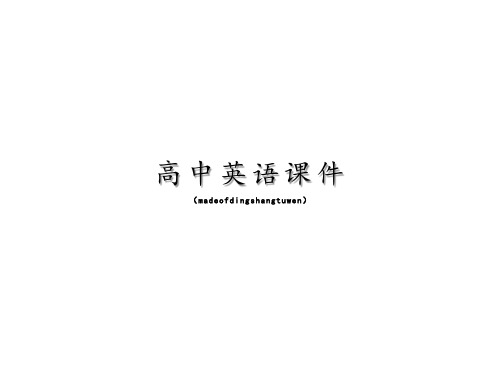
Skimming
Howtogetageneralidea? Readthetext“SchoollifeintheUK” quicklyandanswerthefollowing questions. 1.WhatdidWeiHuathinkofherlifeinUK?
Shethoughtitwasaveryenjoyableandex citingexperience.
3.Whichofthefollowinghastheclosest meaningto“Icouldsende-mailstomy familyandfriendsbackhomeforfree”? A. Icoulde-mailmyfamilyandfriends backhomewithoutpayingmoney. B. Icoulde-mailmyfamilyandfriends backhomefreely. C. Icoulde-mailmyfamilyandfriendsin myfreetime. D. Icouldbefreetoe-mailmyfamilyand friendsbackhome.
Sincerefriendsandclassmateswhenevery oucanturnto.
ReadtheReadingstrategyonpage3and answertwoquestionsbelow:
1.Whydoweskimatext? 2.Howdowedoit? 2.Whydowescanatext? Howdowedoit?
Higherrequirementofstudentsacademicab ility,relativelyhigherburden. Beingateasewithteachers. Offeringmorechancesofconnectingsociety ,concentratingontheformoflifeabilities.
牛津模块1Unit1全单元教学案(译林牛津版高一英语必修一教案教学设计)
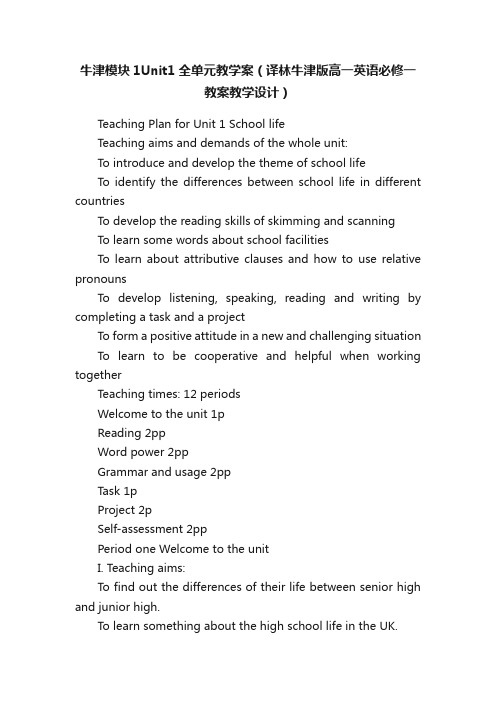
牛津模块1Unit1全单元教学案(译林牛津版高一英语必修一教案教学设计)Teaching Plan for Unit 1 School lifeTeaching aims and demands of the whole unit:To introduce and develop the theme of school lifeTo identify the differences between school life in different countriesTo develop the reading skills of skimming and scanningTo learn some words about school facilitiesTo learn about attributive clauses and how to use relative pronounsTo develop listening, speaking, reading and writing by completing a task and a projectTo form a positive attitude in a new and challenging situation To learn to be cooperative and helpful when working togetherTeaching times: 12 periodsWelcome to the unit 1pReading 2ppWord power 2ppGrammar and usage 2ppTask 1pProject 2pSelf-assessment 2ppPeriod one Welcome to the unitI. Teaching aims:To find out the differences of their life between senior high and junior high.To learn something about the high school life in the UK.To know how to get on well with high school life / study.To find out how an activity attracts the students and helps the studentsII. Teaching Procedures:Step 1 GreetingsStep 2. Warming up and Lead-in1. Let some students make a self-introduction.2. Say something about their junior high school life.Step 3. PresentationPair work: brain storm:When we are talking about our school life, what will we probably think of?Step 4 Comparison (Group work)Here are three pictures that show some aspects of school life in the UK. Please read the instructions, look at the pictures: what’s the difference between schools in China and the UK?Aspects In the UK In ChinaHuge campus and low-rise buildings We can see huge campus and low-rise buildings.It is the biggest difference from schools in China Schools in China usually have a large enough campus to make sure students have enough space to study and play in.But most school buildings are taller, at least three storeys.Lockers for every student There are rows of lockers by the classrooms for students to put their stationary, books, exercise-books and other belongings. Students bring what they need for lessons to school and then take it all back home after school. Most schools in china do not have equipment in the classroom.Fewer students in each class There are fewer students in a class, no more than 30 per class. There are usually more studentsin high school, perhaps 40 to 50 per class. Recently some school are beginning to limit the number of students in each class.At ease with our teacher Students have a close relationship with their teachers. They feel at ease and comfortable with them. It is similar in china. Nowadays, lots of teachers and students have established a good relationship with each other. They respect each other and work to gain a better understanding of each other.Step 5 DiscussionWhat kind of school activities do you enjoy?Do you know any further differences between the schools in the UK and China?What is your dream school life like?What do you think the teachers should be like?What do you think the students should be like?What do you think the relations between teachers and students should be like?Step 6 ExtensionWhat are the factors that will lead to the success of the further?Step 7 SummaryHomework1) Recall all the new words and expressions that appear in this unit.2) Write a short passage about your dream school. (100words)3) Preview the following lesson.Period two ReadingTeaching aims:1. To read a magazine article about school life in the UK.2. To learn to apply two basic reading skills: skimming andscanning.3. To learn some expressions about school life.Teaching procedures:Step 1 RevisionCheck the homework exercise.Step 2 PresentationYesterday discussed the differences between high schools in our country and the UK.Now we are going to read a magazine article which is written by an exchanging student. She has been studying in the UK for one year. Now she gives a clear brief introduction about her school life there.Before we read the article, we are going to learn the reading strategy: skimming and scanning. (P.3: Reading strategy) Skimming: to get a general idea of the article.Focus on the title, heading, captions, the first and last sentences of paragraphs, charts and pictures …Scanning: to locate specific information about an article.Look for key words and phrases, dates and words in bold, italics or capital letters…Step 3 Reading1. Skimming question:How does Wei Hua feel about her life in the UK?2. Scanning:1) What topics are mentioned in the WeiHua’s letter?(opt. are the following aspects of school life mentioned in the article?Teachers classmates friends subjects homework grades timetable activities school facilities host family food hobbies customs traditions festivals)2) Scan the passage and complete Part C1, C2 on page 4Step 4 Group workWhat’s the similarity and difference between the schools in China and the UK?★Aspects In the UK In ChinasimilaritydifferenceStep 5 Practice:Pair workNow you are a reporter from the school magazine, and have a chance to interview Wei Hua. What other information would you like to know about her life and study in the UK?Suppose your desk mate is Wei Hua, make a dialogue.Homework.1. Complete parts D and E2. Read the two articles in reading on pages 82 and 83 in wb and answers the questions below them.3. Daniel Adams will come to your school as an exchange student. Write a letter to him and introduce your school life to him.4. Preview the following lesson.Period three Language focusStep 1 Revision:1. Check the homework2. Complete the chart and retell the letter.On the first dayTeachers Mr. HeywoodMiss BurkeSize of a classroomSubjectsFoodWei Hua’s feelings and progressStep 2. Language focus1. Words:a) attend (join / join in / take part in )b) preparec) miss (missing / gone / lost)d) experiencee) informationf) sounds2. Phrases:a) for freeb) a bit / a littlec) as well as3. Sentences:a) Going to a British school for one year has been a very enjoyable and exciting experience for me.b) I do like eating.Step 5. Practice1. Complete wb A1, A2,2. Translation1)Jim加入了我们的讨论之列。
- 1、下载文档前请自行甄别文档内容的完整性,平台不提供额外的编辑、内容补充、找答案等附加服务。
- 2、"仅部分预览"的文档,不可在线预览部分如存在完整性等问题,可反馈申请退款(可完整预览的文档不适用该条件!)。
- 3、如文档侵犯您的权益,请联系客服反馈,我们会尽快为您处理(人工客服工作时间:9:00-18:30)。
牛津英语译林版高一必修一Unit1 教案Unit 1School lifeTeaching aims of the whole unit:1. Develop students ability’ of reading comprehension by reading an article about school lifein the UK and two other articles about school clubs.2. Develop students ability’ of listening comprehension by listening to two talks aboutschool activities.3. Develop students speaking’ ability by discussing daily school life and reporting school activities.4. Develop students writing’ ability by writing a notice about school activities.5. Develop students integrated’ skills of using English by making a poster for a school club. 6. Enlarge students vocabulary’ about school facilities.7 Help students understand what an attributive clause is and what relative words function as in attributive clauses; teach students how to use relative pronouns that, which, who, whom and whose.Period arrangement:The whole unit: 12 periodsWelcome to the unit: 1 periodReading: 2 periodsWord power: 1 periodGrammar and usage: 2 periodsTask: 2 periodsProject: 2 periodsSelf-assessment: 1 periodRevision and exercises: 1 periodPeriod 1Welcome to the unitI. Teaching aims:1 Get students to know the different high school loves between the UK and China.2 Develop students ’ English speakinglls. skiII. Teaching Procedures:Step 1. Warming upLet some students make a self-introduction.1. Introduce themselves.2. Say something about their junior high school life.3. Pair work: brain storm:When we are talking about our school life, what will we probably think of?What words or phrases will we use to describe our school life?Step 2 Presentation1. Say the following to students:It s’the beginni ng of the new term. You ’ ve just finished your junior high and are about to enter a new period in your studies. I am happy to give your lessons and I hope we can be friends.I can see that some of your are eager to know what studying at senior high will be like. Will it be differ4ent from junior high? Well, there are certainly many differences between junior high and senior high, but there are also some things that are the same in every school in China.What about schools in other countries? Do you have different experiences? Are schools allover the world the same? This is the subject of our first unit.2. Ask students to read the instruction and tell them:Here are three pictures that show some aspects of school life in the UK. Please read the instructions, look at the pictures: what's the difference between schools in China and the UK?Step 3 Discussion1 Ask students the following questions to talk about the words in the four pictures:Huge campus and low-rise buildingsWhat does huge mean?What does low-rise mean?What about campus and school buildings in China?(Schools in China usually have a large enough campus to make sure students have enough space to study and play. But most school buildings have at least 3 storeys.)Lockers for every studentDo you know what a locker is?(There are rows of lockers by the classrooms for students to put their bookd, exercise-booksand other belongings.)What do you think about locker for students?Do you think that we should have such locker in our school? Why or Why not?Fewer students in each classHow many students are there in our class?Do you know the number of students in a class in the UK?At ease with our teacherWhat can we know from this picture?What does the word ease mean? What do you think the phrase at ease mean?Were you getting on well with the teacher when you were in junior high?What relationship do you want to have with your teachers in senior high?2 Ask students to work in groups to talk about the four pictures and the differences between schools in the UK and China. Then ask several students to report their discussion to thewhole class.aspects In the UK In ChinaHuge campus and We can see huge campus Schools in China usually have a large enoughlow-rise buildings and low-rise buildings. campus to make sure students have enough space to It is the biggest difference study and play in.from schools in China But most school buildings are taller, at least threestoreys.Lockers for every There are rows of lockers Students bring what they need for lessons to school student by the classrooms for and then take it all back home after school. Most students to put their schools in china do not have equipment in theFewer students in each class stationary, books,classroom.exercise-books and otherbelongings.There are fewer students There are usually more students in high school, in a class, no more than perhaps 40 to 50 per class. Recently some schools 30 per class.are beginning to limit the number of students ineach class.At ease with our Students have a close It is similar in china. Nowadays, lots of teachers and teacher relationship with their students have established a good relationship with teachers. They feel at ease each other. They respect each other and work toand comfortable with gain a better understanding of each other.them.3. Ask students to discuss the three questions in pairs, and them ask some of them to report their answers to the questions to the whole class.What is your dream school life like?What kind of school activities do you enjoy?What do you think of your life here in the new school?Step 4 Summary and HomeworkToday we ’ ve mainly talked about the differences between the high school lives in the UK and in China. After class you should:1) Recall all the new words and expressions that we learn in this lesson.2) Find more about any other differences between the high school lives in the UK and in China, either by surf the Internet or by reading some articles in newspapers or magazines.3) Preview the following part: reading (page 2 to page 4).4)。
